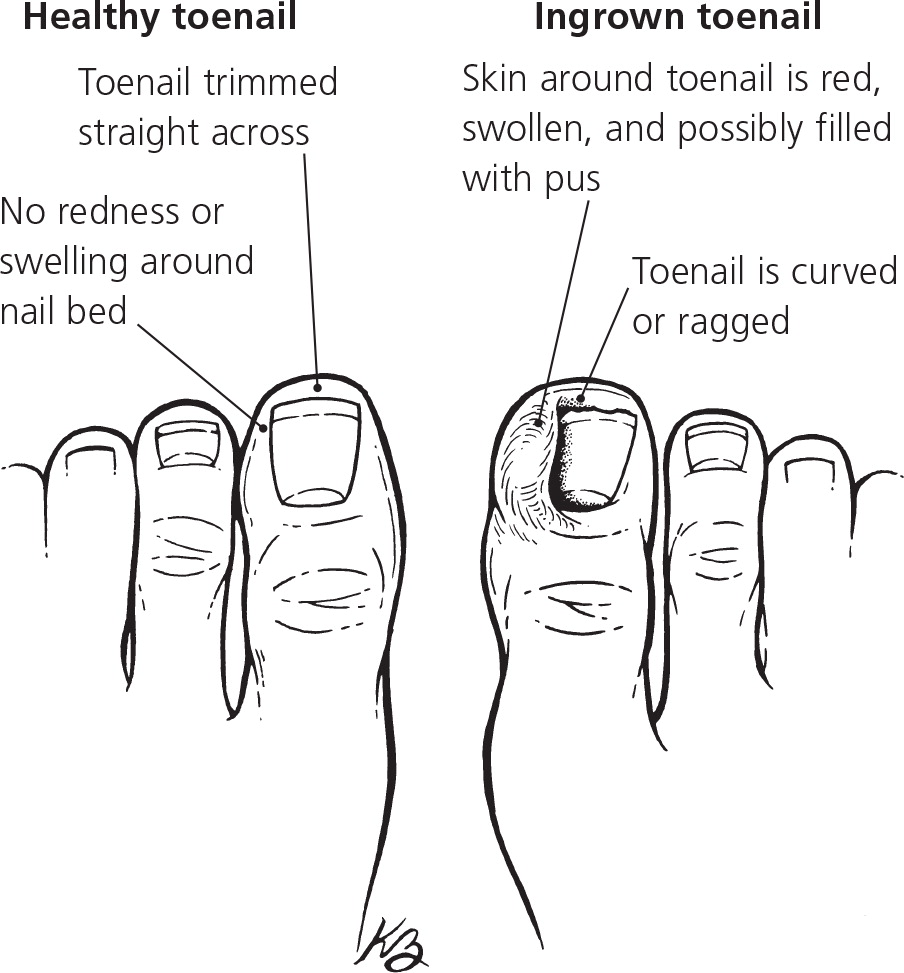
Am Fam Physician. 2019;100(3):online
See related article on ingrown toenail management
What is an ingrown toenail?
An ingrown toenail occurs when the side or corner of the nail digs into the skin of the toe. This happens mostly to the big toenail, but it can happen to any toenail.
What are the symptoms of an ingrown toenail?
You may have redness, swelling, and pain on your toe around the edge of the nail (see drawing).

What causes an ingrown toenail?
Many things can cause ingrown toenails. One main cause is wearing shoes that do not fit well. Shoes that are too tight or too small can press the skin of your toe into your toenail. Incorrectly cutting your toenails is another main cause. Toenails that are peeled off at the edge or trimmed down at the corners are more likely to become ingrown. An injury to your toe also can cause an ingrown toenail. People who have deformed or misshaped toenails have a higher risk of ingrown toenails.
How is an ingrown toenail diagnosed?
Your doctor can examine your toe and toenail. If you have an ingrown toenail, your doctor may order treatment. Tell your doctor if you get ingrown toenails often. People who have diabetes are at risk of complications from an ingrown toenail. Also tell your doctor if you are or may be pregnant because some treatments cannot be used during pregnancy.
Can an ingrown toenail be prevented or avoided?
To avoid ingrown toenails, cut your nails straight across. The top of your nail should make a straight line. Do not pick at your nails or tear them at the corners. Wear shoes that fit correctly and allow plenty of room for your toes. Avoid high heels and tight-fitting shoes.
What is the treatment for ingrown toenails?
Mild ingrown toenails can be treated at home. Soak your foot in warm water for 15 to 20 minutes. Dry your foot, then place a twist of cotton under the corner of your nail. You can wet the cotton with water or a disinfectant. This should be changed at least once a day. Try to wear open-toe shoes, such as sandals, that do not rub the toenail. This will help healing and remove chances of irritation. Contact your doctor if your ingrown toenail does not improve or gets worse, including increased pain, swelling, and drainage.
An ingrown toenail may require minor office surgery. The procedure involves removing the part of the nail that is ingrown. Before surgery, the doctor will numb your toe by injecting it with medicine. The doctor will lift your toenail along the edge that is growing into your skin. Then, the doctor will cut and pull out that piece of nail. The doctor may apply a small electrical charge or liquid solution to the exposed part of your nail bed. This is called ablation. It should keep the toenail from growing into your skin again. Not all people need ablation.
Instructions to follow after office surgery for ingrown toenail:
Soak your foot in warm water each day.
Keep a bandage over the site until it heals.
Take acetaminophen (brand name: Tylenol) or ibuprofen (brand name: Motrin) as needed for pain.
Keep the wound clean and dry; you may shower the day after surgery.
Wear loose fitting shoes or open-toe shoes for the first two weeks.
Avoid running or strenuous activity for the first two weeks.
Call your doctor if the toe is not healing.
Living with an ingrown toenail?
Treatment—at home or from your doctor—helps treat symptoms and heal the toe. After the toe heals, practice good foot care to prevent future problems and to keep an ingrown toenail from coming back. If you have surgery, it may take two to four months for your toenail to grow back.
Questions for your doctor
What is the cause of my ingrown toenail?
What type of treatment will heal my toenail? Will I need surgery?
What kind of shoes should I wear?
Can you show me how to trim my nails?
What is my risk of ingrown toenail coming back?
